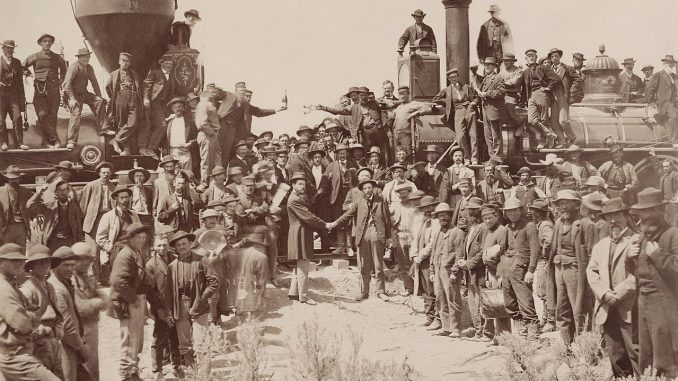
Completing the First Transcontinental Railroad was among the most significant railroad accomplishments, if not the single greatest, in railroad history.
Workers completed the line on May 10, 1869, 150 years ago today.
“Next to winning the Civil War and abolishing slavery, building the first transcontinental railroad, from Omaha, Nebraska, to Sacramento, California, was the greatest achievement of the American people in the nineteenth century,” Stephen Ambrose said his book about the railroad.
Early Proposals
Proponents of a transcontinental railroad discussed the idea as early as the 1840s.
“In the 1850s surveyors examined four possible rail routes to the Pacific, ranging from north to south, and found that each was feasible,” said Steve Storey, librarian at the Southeastern Railway Museum. “They presented their report to Jefferson Davis, then the Secretary of War, who as a Mississippian predictably favored the southern route between New Orleans and San Diego.
“Davis correctly argued that its mountain barriers would be more easily breached than those to the north, but civil engineering matters were not the only consideration at the time,” Storey said. “A greater barrier to a southern transcontinental was Northern opposition to slavery and its possible expansion to the West which that railroad would make more likely. In April 1861 the South effectively yielded on the issue, and a southern transcontinental would not open for another twenty years.”
The idea gained steam when President Abraham Lincoln signed the Pacific Railroad Act of 1862 into law on July 1, 1862. The law created a pair of companies to construct the railroad: the Central Pacific Railroad Company of California (CPRR) in the west and the Union Pacific in the Midwest.
The Work
The Central Pacific broke ground on its portion of the project on January 8, 1863, during the Civil War. The Union Pacific began construction in July 1865, shortly after the end of the war. The railroads met at Promontory Summit.
In the end, the Central Pacific built 690 miles eastward from Sacramento, while the Union Pacific built 1,085 miles westward from Omaha. Photographer Andrew J. Russell captured the moment in one of the most famous photographs in history.
“The completion of the Transcontinental Railroad transformed the travel time from coast to coast to being measured in days instead of months,” said Lloyd Neal, assistant librarian at the Southeastern Railway Museum. “Travel before the completion was either by ship taking round about routes or by land for about 2000 miles by foot or animal power. The times involved in both the sea or land travel were little changed since ancient times.
“The construction of the Transcontinental Railroad demonstrated the American Spirit of optimism, determination, curiosity and dreams of a better tomorrow,” Neal said. “The Chinese and Irish emigrants who built the Transcontinental Railroad caught that American Spirit and we all better for it.”
The railroad replaced the route after opening the “Lucin Cutoff” from Ogden, Utah, to Lucin, Utah, in 1904. Rails at Promontory Summit were removed and recycled for the World War II effort during an “undriving” of the last spike ceremony.
Portions of this article were adapted (with permission) from Railfanning.org. Todd DeFeo is the author of the forthcoming book, Western & Atlantic Railroad (Images of Rail).


